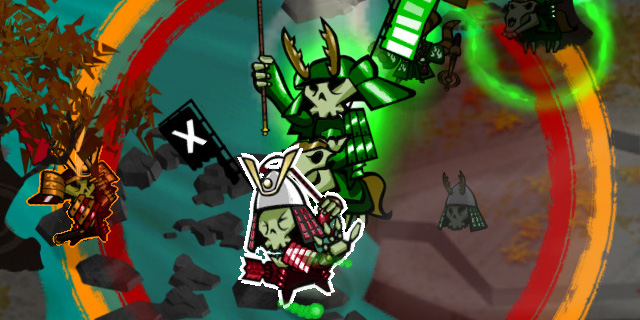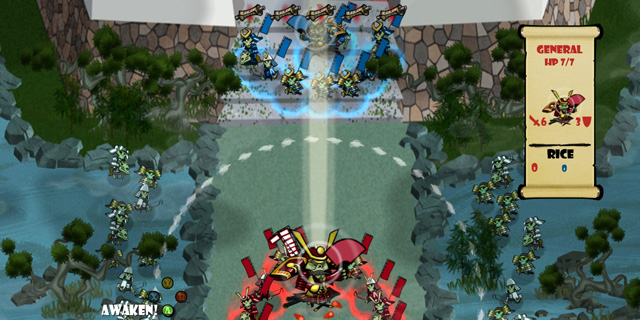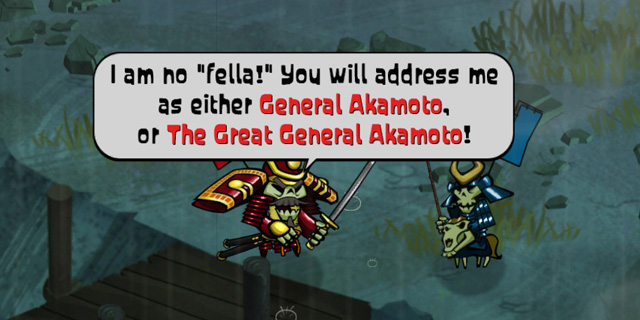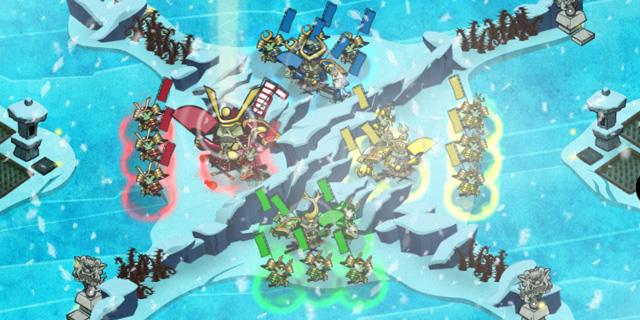
17-Bit’s Skulls of the Shogun has been a highlight of indie festivals and competitions for a few years now. The turn-based strategy game is, even before release, known for its pick-up-and-play nature and subtle tactics. Its transformation into a multi-platform, Windows-8-and-Windows-Phone-showpiece project has caused it to take a bit longer to get to our hands, and also raises inevitable concerns about development priorities. We’re happy to say that it had little effect on the game itself, and that the full release of Skulls delivers on a lot of the promise of that earlier work.
Simply described, Skulls of the Shogun is a strategy game, taking many of the basic mechanics of games like Advance Wars (such as infantry, ranged units and territory control) and applying a free-movement system and a silly-Japanese-undead aesthetic. Each turn, you may move units up to a certain radius, take an action (like attacking or “haunting,” the game’s version of capturing) and finish a turn by using any remaining movement. The general is stronger, but if he’s killed, you lose, making using him a risk. Regardless of your number of units, you may only move five of them each turn. This, combined with a damage-counterattack balance that favors conservative play, makes for a much more reserved, thought-heavy experience.

The little things
Some of the aesthetic details in the game are just fun. Even though HP is listed to the side, you’ll never look there, because each unit’s banner indicates how much life it has left. If you can hit a unit and it won’t counter, it’ll be cowering in fear. (Of course, if it will, it’ll be suitably fierce.) These things inject personality, but they’re also useful!
17-Bit kept it simple with the game’s base units. There’s the high-defense, slower infantry unit, the faster-but-vulnerable cavalry unit and the ranged archer. A formation is important, even in a free-movement game, as putting units near each other creates an impenetrable “spirit wall” to put units behind. If you attack with an archer from behind a wall, it won’t get counter-attacked by other ranged units. There’s also a bit of knockback at play, and staying in a wall means you won’t get knocked over a cliff. (Until the opponent kills part of your wall and breaks it up, that is.)
You can make any unit stronger by eating the game’s titular skulls. Defeating an enemy leaves a skull on the field, and if you take an action to eat one, the unit’s max HP increases. Eating three transforms a unit into a demon, giving it an extra action a turn. (This is especially valuable in a game that only lets you use five units a turn, as it’s the only way to escalate an assault.) The general can also become a demon, gaining a third action and becoming a true force to be reckoned with.
Maps often have one or two of the game’s special mechanics at play to spice things up. There are advanced Monk units that you summon by haunting shrines. The three do different things, and learn more abilities when fed skulls: the Salamander is a high-potency ranged unit that can summon uncontrollable Oni, the Fox is a healer that learns support abilities, and the Crow blows units off cliffs and steals resources.

Text troubles
Skulls uses three typefaces: the decorative one, seen in the logo and reserved for special treatments; a playful-but-readable one, used for dialogue (see above); and a third for interface elements. This third one is hard to read and often placed over backgrounds that exacerbate the problem. It also just feels a bit rough, and was generally a bad decision to use for pertinent information.
Skulls‘ campaign follows General Akamoto through his journey in the Land of the Dead, getting revenge on his subordinate, Kurokawa, who killed him in battle and now pretends to be Akamoto and leads undead forces. The writing is silly, and is well aware of its purpose to convey new game mechanics and get out of the way. This isn’t an RPG, and it doesn’t try to be.
The progression of the campaign is an interesting one; not only does it slowly introduce mechanics (like special units and abilities), but it also uses this ramp-up to create thought-provoking levels given these constraints. That you don’t have healing yet, or don’t have access to the General’s second attack, means something to the gameplay. These levels are certainly easier to simply complete, but the incentive to do more lies in earning golden skulls. Each map has a set of special objectives to complete, and doing so gets you one of three skulls. You don’t have to do them all at once (and some are impossible to complete simultaneously), but finding a way to beat a map without losing any units, or without using your General at all, can be compelling indeed.

The Multitap angle
We’re happy to see the “Skulls on the Couch” mode providing local play for up to four. That said, some advisories: first, that pacing issue? Worse when there are long-eliminated sitting around waiting for that last runaway unit to fall. Second: the game offers single-pad play, and use it. Otherwise, you have to keep turning eliminated players’ controllers back on as they turn off due to inactivity and the game freaks out.
Skulls is designed to be a multiplayer game first and foremost, though, and 17-Bit provides a lot of options. You can play online or locally in the traditional form, or you can play what it calls Skulls Anywhere, the asynchronous sort of turn-taking play that has become super-prevalent in mobile and social games. We reviewed the game on XBLA, but the game seems well-designed for touch interfaces, and really has always had the sorts of mechanics that developed-later, released-earlier touch-based games have found a lot of success with. There is unfortunately no framework for cross-purchasing on any of these platforms yet, but 17-Bit is discounting other versions at launch to help a bit if you want to dive in.
The multiplayer itself is interesting, though it falls into some of the pitfalls of the genre. The endgame in particular is a bit trying, as there’s very little chance that a decimated squad can pull off a win, but there’s every chance that a shrewd general unit can stick, move and feast on skulls for quite a few turns. That same five-moves-per-turn limit that keeps slightly-unbalanced match-ups competitive drags out a map’s finish.
Skulls of the Shogun provides a solid, well-thought-out experience in a genre that needed more accessible titles. It’s not the next craze or anything, and the pacing issues will hold back play that isn’t asynchronous, but it does a lot of things right and is one of the best XBLA offerings we’ve seen in some time.
Pros: Well-considered strategy, lots of multiplayer options
Cons: Troubling endgame pacing, minor aesthetic issues



















